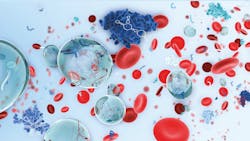Historically, tissue has been the “gold standard” sample type for mutation profiling in oncology. More recently, analysis of blood and other body fluids has increased to complement tissue analysis and to support patient management in cancer. In patients for whom no tissue sample is available (e.g., due to the invasive and high-risk nature of the tumor biopsy procedures), a liquid biopsy is the only possibility to obtain mutation information for an optimal treatment decision. Collection of body fluid is less invasive and blood (plasma, serum), urine, cerebrospinal fluid, saliva, etc., can provide the relevant information about tumor heterogeneity. This information is almost impossible to obtain using tissue, since this would involve numerous tissue biopsies and necessitate knowledge of all existing lesions.
Despite these factors, liquid biopsy is not yet widely established as a routine diagnostic test within cancer patient management and there are challenges still to be overcome.
Analytes in liquid biopsy
Different circulating analytes, such as circulating cell-free DNA and RNA, circulating tumor cells (CTCs), exosomes and proteins have been identified in liquid biopsy and their diagnostic potential evaluated. The use of these analytes in cancer diagnostics has advantages, as well as limitations. An advantage of CTCs is their utility in cell morphology analysis, whereas ctDNA supports the use of highly sensitive detection methods.
Most advanced with respect to diagnostics is probably the analysis of circulating tumor DNA (ctDNA) in plasma, which is evidenced by several FDA-approved diagnostic tests. Standard methods for mutation profiling in liquid biopsy are currently PCR techniques, supporting a limited number of genes and short turnaround time, as well as next-generation sequencing (NGS) for a comprehensive panel of markers. Various mutation types (e.g., point mutations, small insertions and deletions, copy number variations or methylation markers) can be detected.
The use of ctDNA in cancer diagnostics has tremendous potential: early diagnosis, prognosis, treatment decisions, therapy and disease monitoring (including early identification of resistance mutations and recurrence testing). Liquid biopsies are used in various cancer types, especially lung, breast and prostate cancer. Even in brain cancer, recent data have shown that liquid biopsy can predict prognosis in patients. In addition to oncology, liquid biopsy can also be used in other applications, including reproductive health and other diseases.
At initial diagnosis, the mutation status is important for treatment decisions, since targeted therapies require mutation testing. Tumor heterogeneity is not (depending on the disease stage at diagnosis) the driver for liquid biopsy at initial diagnosis, rather the absence of tissue material. During therapy, monitoring of the disease can be supported by liquid biopsy testing, as the variant allele frequency (VAF) of driver mutations are expected to decrease and provide information related to therapy response. New resistance mutations may occur and can be detected in blood earlier than progression can be detected by other tools. Tumor heterogeneity at this disease stage is an important factor to consider for additional therapy decisions and liquid biopsy can reveal mutations of different lesions or metastases.
Challenges
The diagnostic workflow using liquid biopsy is not limited to just an assay: the workflow includes the complete preanalytical process from sample collection and handling through to data analysis. Each individual step within the workflow contributes to the robust result of a liquid biopsy procedure and therefore, the overall workflow needs to be standardized and optimized for the reproducible results that are a prerequisite for use in clinical routine testing.
Limitations are known; for example, low concentrations of ctDNA in blood. Circulating DNA includes circulating tumor DNA, but also normal circulating DNA and sometimes genomic DNA from blood cells. The ctDNA is released by tumor cells of the primary tumor, circulating tumor cells (CTCs) or metastases. Therefore, ctDNA concentration fluctuates and data may be inconclusive; affected by tumor size or disease stage, for example. Clinical data have demonstrated that very low amounts of ctDNA (less than 10 copies per 5 ml plasma) or up to 100-fold concentrations can be detected in a patient specimen. Therefore, liquid biopsy assays require highly sensitive detection methods to identify individual tumor-derived molecules in a background of unmutated DNA. The preanalytical sample handling and processing is crucial to avoid degradation of clinically relevant ctDNA before even starting the detection step of the diagnostic workflow. Blood collection tubes that stabilize circulating tumor DNA in whole blood are essential to avoid ctDNA degradation or release of gDNA from blood cells. The half-life of circulating cell-free DNA is less than one hour. Therefore, the sample collection and tube handling processes also impact the outcome and therefore the diagnostic result. The nucleic acid extraction process is crucial to ensuring sufficient ctDNA and, of a quality high enough to allow the identification of low-frequency variants. In early diagnosis or minimal residual disease testing, low concentrations of mutated ctDNA are expected. Optimized data analysis tools are important to avoid false-positive or false-negative results that may lead to poor decisions in patient management. In addition, various parameters influence the rate of ctDNA shedding into the blood and more data, as well as standardization of sample collection is required. In routine diagnostic testing, a negative liquid biopsy is currently followed by a reflex tissue biopsy (where feasible), as the result may be influenced by the limitations discussed above.
Conducting clinical studies to support implementation of liquid biopsy into clinical routine is an ongoing activity. Reimbursement is limited and additional efforts, especially related to clinical validation, are required to ensure comprehensive mutation profile analyses using liquid biopsy. Inclusion in treatment guidelines requires adequate clinical efficiency of diagnostic tests. Reimbursement limitations are currently one of the biggest obstacles preventing utilization of liquid biopsy applications in cancer management.
Outlook
In addition to individual, approved liquid biopsy tests, comprehensive performance evaluation to support use of liquid biopsy in routine diagnostic is required. Additional tests for various analytes are required to cover the complete range of genomic alterations, including rearrangements. Clinical performance data are required to verify which allelic frequencies are clinically relevant, in order to ensure adequate analytical performance for individual use cases, cancer types and other diseases. As a high number of parameters from sample collection to data analysis influence the diagnostic result and therefore the patient management, studies are crucial to show concordance across available liquid biopsy tests and standardization of liquid biopsy workflows must be implemented. Consistency of results will support clinical guidance, which further impacts reimbursement decisions, as coverage is key to ensuring availability of these tests for all patients.
Standardization across the complete workflow has already begun, but more procedures and guidelines are required to support optimal patient management using these minimally or non-invasive procedures. To provide sufficient scientific evidence supporting the validity, clinical utility (as well as the effectiveness of mutation detection using ctDNA in cancer), a close collaboration of diagnostic test providers, pharma industry, as well as academic and clinical institutions, is required. This will make it possible to implement liquid biopsy applications in routine diagnostics and positively impact cancer patients. A broad use for multiple cancer types in diagnosis and disease monitoring based on guidelines for clinical practice will be a first milestone, and cancer screening applications will surely follow in the future.






